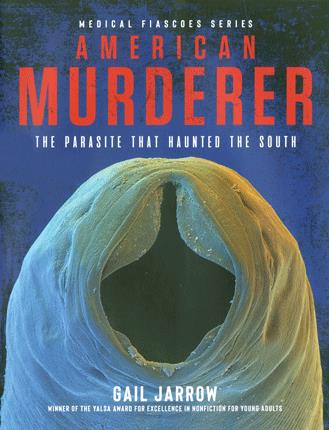| American murderer : the parasite that haunted the South (Medical Fiascoes) Author: Jarrow, Gail | ||
| Price: $27.98 | ||
Summary:
Imagine microscopic worms living in the soil. They enter your body through your bare feet, travel to your intestines, and stay there for years sucking your blood like vampires. You feel exhausted. You get sick easily. It sounds like a nightmare, but that's what happened in the American South during the 1800s and early 1900s. Doctors never guessed that hookworms were making patients ill, but zoologist Charles Stiles knew better.
| Accelerated Reader Information: Interest Level: MG Reading Level: 8.20 Points: 5.0 Quiz: 519008 |
Reviews:
Kirkus Reviews (08/01/22)
School Library Journal (09/01/22)
Booklist (+) (08/01/22)
The Bulletin of the Center for Children's Books (00/07/22)
The Hornbook (00/09/22)
Full Text Reviews:
School Library Journal - 09/01/2022 Gr 5–9—Jarrow continues her "Medical Fiascoes" series with this concise yet fascinating history of hookworm disease in the American South. By the early 20th century, large populations in the South were suffering from an unknown illness that left them emaciated, anemic, and unable to work. This was primarily occurring in rural poor communities. At the time, hookworm disease was largely unknown and rarely diagnosed by American doctors, despite it occurring for several decades in the South as well as in other countries. One doctor, Charles Stiles, a renowned parasitologist who worked for the USDA and later the Public Health Service, found that it was easy to diagnose, treat, and prevent. He dedicated much of his career to educating people about this debilitating illness. He faced obstacles on multiple fronts, including cultural resistance to outsiders, economic obstacles to updating sanitary conditions, and his less than charming personality that did not win him many supporters. For the first half of the book, with her usual flair, Jarrow highlights the science of hookworms, which has plenty of gross appeal to keep readers engaged. The second half is equally intriguing as she focuses on Stiles's tireless efforts along with the cultural and historical aspects of the period. VERDICT An excellent addition for middle and high school students.—Karen T. Bilton - Copyright 2022 Publishers Weekly, Library Journal and/or School Library Journal used with permission.
School Library Journal - 09/01/2022 - Copyright 2022 Publishers Weekly, Library Journal and/or School Library Journal used with permission.
School Library Journal - 09/01/2022 - Copyright 2022 Publishers Weekly, Library Journal and/or School Library Journal used with permission.
Booklist - 08/01/2022 *Starred Review* The terrifying cover of this latest installment in the award-winning Medical Fiascoes series features an enlarged photo of an alienlike creature with a toothy, gaping mouth that will instantly lure readers drawn to the creepier side of life. Jarrow’s impeccable research and fascinating details will keep them hooked, especially when they discover that this creature, known as Necator americanus—the American murderer—is a hookworm that once plagued the South. Although the hookworm was present long before the turn of the twentieth century, Jarrow focuses on this time period when Charles Stiles, a zoologist for the U.S. Department of Agriculture, began to piece together a puzzling mystery. Millions of Southerners were suffering from such ailments as anemia, fatigue, and malnourishment, or what came to be known as the “laziness germ,” as those infected were unable to learn or work for an extended time. Jarrow describes how Stiles concluded that sufferers were actually infected by a parasite and follows his fervent campaign to educate and cure the South. The author also addresses socioeconomic influences, explaining the impetus of Southern stereotypes and how a lack of sanitation in poor communities contributed to the hookworm’s rise. Numerous archival photos place readers in the time period, while a concluding chapter looks at ongoing parasitic-worm dangers across the globe. An engrossing blend of history and STEM. - Copyright 2022 Booklist.




